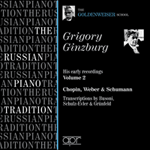
Welcome to Hyperion Records, an independent British classical label devoted to presenting high-quality recordings of music of all styles and from all periods from the twelfth century to the twenty-first.
Hyperion offers both CDs, and downloads in a number of formats. The site is also available in several languages.
Please use the dropdown buttons to set your preferred options, or use the checkbox to accept the defaults.

| Grigory Ginzburg (piano)» More |
from notes by Frank Cooper © 2011
extrait des notes rédigées par Frank Cooper © 2011
Français: Hypérion
aus dem Begleittext von Frank Cooper © 2011
Deutsch: Viola Scheffel
 Grigory Ginzburg - His early recordings – 2 Grigory Ginzburg - His early recordings – 2‘Grigory Ginzburg (1904-61) was a 'quiet pianist' who none the less offers a 'masterclass in keyboard mastery'. This, finely put, offers a clue toward ... ‘Ginzburg has been well served over the years … a harmonious look at his early studio recordings and they are complementary and indispensable it ...» More |

